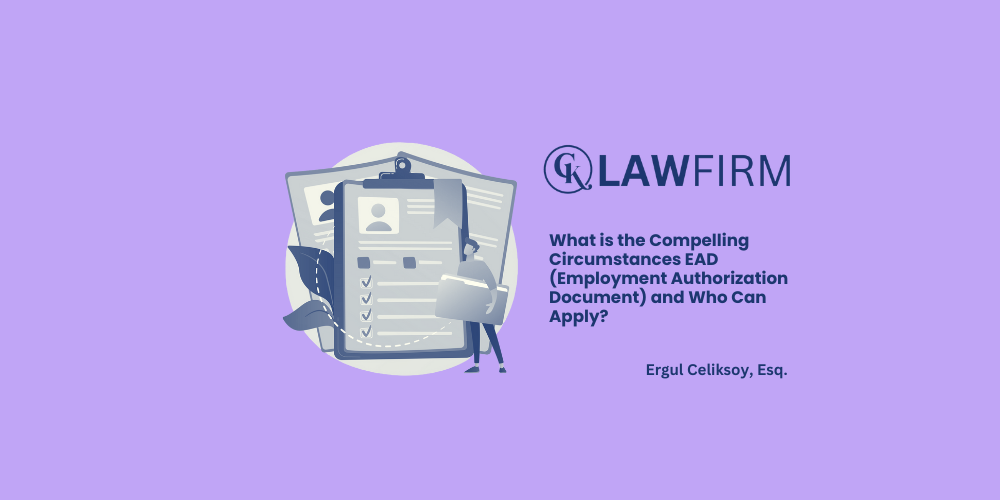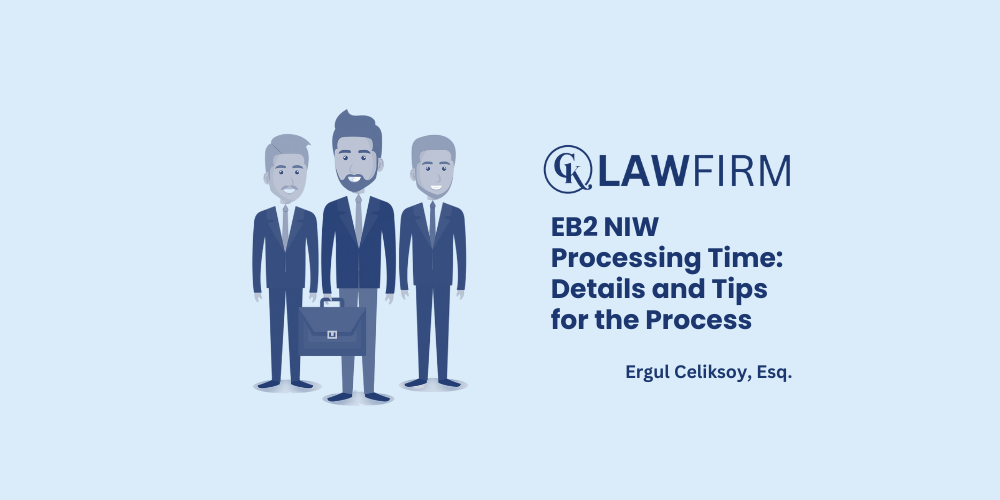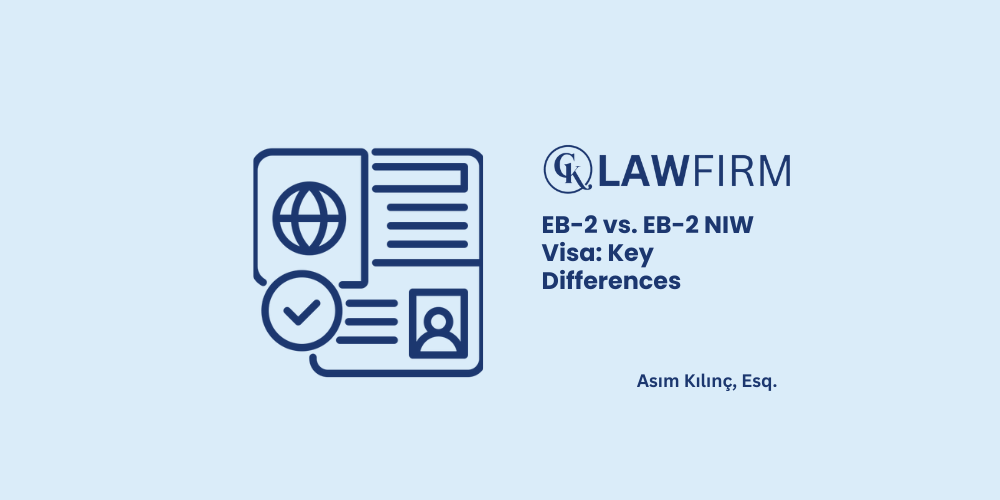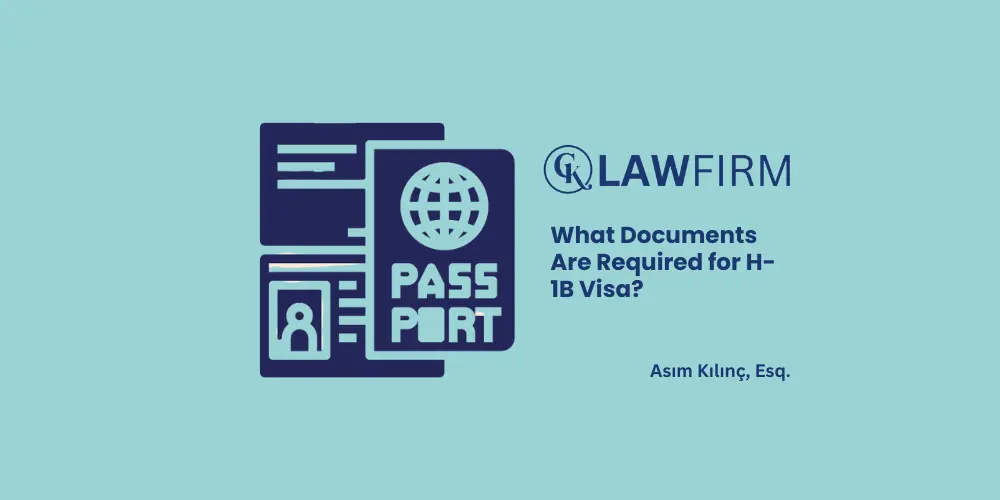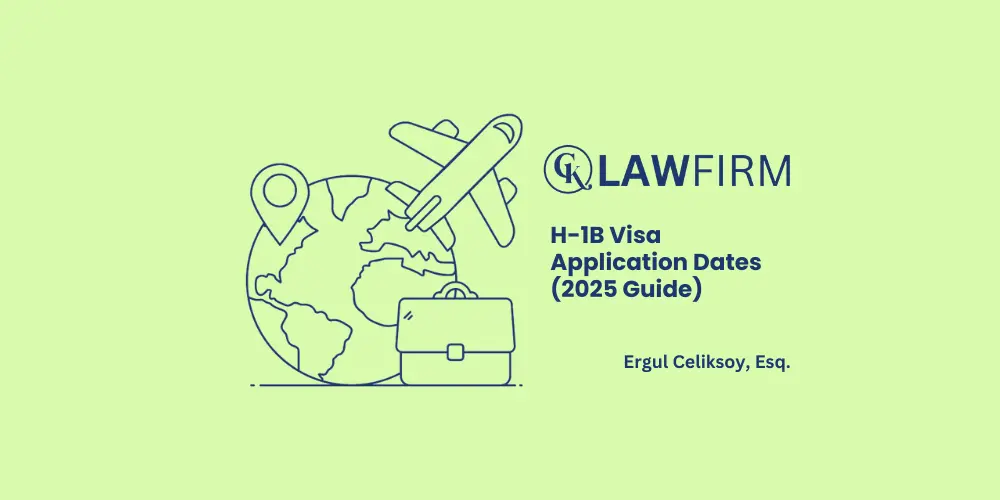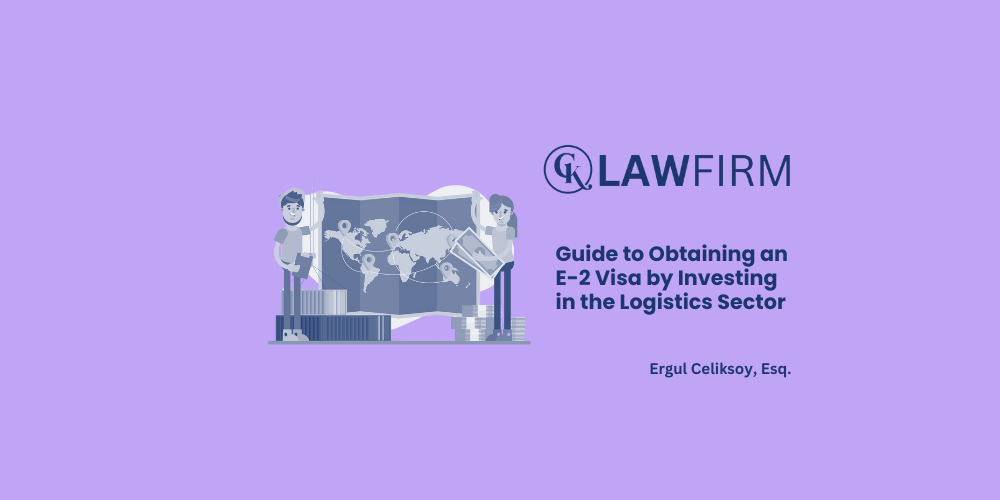Schedule an Appointment with Our Attorneys Now
By Ergul Celiksoy, Immigration Attorney at CK Law Firm
In the U.S., individuals dependent on a specific visa type may face risks of job loss due to employer changes, economic hardships, or other reasons. To address such challenges, the Compelling Circumstances Employment Authorization Document (EAD) provides a legal work authorization solution. This document is particularly designed for individuals in the Green Card process but awaiting a final decision. In this article, we’ll address the following key questions:
- What is the Purpose of the Compelling Circumstances EAD?
- How Does the Application Process Work?
- Who is Eligible to Apply?
- What Are the Benefits of the Compelling Circumstances EAD?
If you have additional questions, feel free to reach out via the comments section below this article, through LinkedIn, or directly via the CK Law Firm website!
What is the Purpose of the Compelling Circumstances EAD?
The Compelling Circumstances EAD aims to assist individuals tied to a specific employer through their visa status in overcoming financial and personal hardships in case of job loss. The U.S. Citizenship and Immigration Services (USCIS) evaluates applications based on the following criteria:
- Economic Impact: The financial consequences of unemployment on the applicant and their family.
- Social Impact: Potential negative effects on U.S. employers, clients, or the community due to the lack of work authorization.
- Immigration Compliance: The applicant’s adherence to past immigration and work authorization requirements.
This authorization is particularly crucial for individuals whose Green Card petitions (I-140) have been approved but are waiting for a visa number. It also provides a temporary solution for those holding employer-sponsored visas such as H-1B or L-1, who are at risk of losing their jobs.
How Does the Application Process Work?
Applying for a Compelling Circumstances EAD involves specific steps:
- Completing Form I-765: This is the primary form required by USCIS for work authorization.
- Providing Supporting Evidence: Documents proving compelling circumstances (e.g., job loss, health issues, financial hardships).
- Submitting Immigration Status Documentation: Approval notice of I-140, proof of current visa status, and any relevant employment agreements.
Once the application is submitted, USCIS conducts a thorough review of the applicant’s circumstances. Each application is evaluated on its merits, taking into account the unique details of the applicant’s case.
Who is Eligible to Apply?
The Compelling Circumstances EAD is available to individuals meeting specific criteria:
- Green Card Applicants: Those with approved I-140 forms but waiting for visa availability.
- H-1B or L-1 Visa Holders: Individuals who have separated from their employers and are seeking new job opportunities.
- Non-Immigrant Visa Holders: Individuals whose current visas are nearing expiration but can demonstrate compelling circumstances.
Approval rates depend on the strength of supporting evidence and the severity of the circumstances. USCIS also considers the applicant’s prior compliance with immigration laws.
What Are the Benefits of the Compelling Circumstances EAD?
- Temporary Solution: Provides work authorization while waiting for a visa number.
- Flexibility: Eliminates dependency on a single employer and opens new job opportunities.
- Support for the Immigration Process: Ensures uninterrupted progress in the Green Card application process.
Conclusion
Applying for a Compelling Circumstances EAD can be a complex process. Since each case is unique, working with an immigration attorney can significantly increase the chances of a successful application. For professional assistance, detailed information, or consultation services, feel free to contact us at cklawfirm.org, info@cklawfirm.org, or via LinkedIn.
Who is Attorney Ergül Çeliksoy?
Attorney Dr. Ergül Çeliksoy is a founding partner of CK Law Firm and also serves as an Assistant Professor of Law at the University of Nottingham. With extensive experience in U.S. immigration law, Dr. Çeliksoy completed a Master’s degree in international law and human rights law at the University of Nottingham in 2017, followed by a Ph.D. at the same university. His Ph.D., completed in 2022 at the University of Nottingham School of Law, marked a significant milestone in his academic career. Dr. Çeliksoy has published extensively in leading academic journals and is internationally recognized for his expertise in modern slavery, criminal justice, and criminal law. As a member of the California Bar, Dr. Çeliksoy offers exceptional service to his clients, particularly in U.S. immigration law cases. His expertise and experience in immigration law significantly contribute to CK Law Firm’s work in this area.
Dr. Çeliksoy provides comprehensive and strategic solutions to his clients in immigration law cases, helping secure their legal status in the U.S. His work on human rights and immigration processes, particularly in modern slavery and criminal law, effectively addresses the complex legal issues immigrants face. Dr. Çeliksoy reinforces CK Law Firm’s leadership in immigration law by offering reliable and effective legal consulting services to his clients, helping them build new lives in the United States.
By Ergul Celiksoy, Immigration Attorney at CK Law Firm
The EB2 NIW application process can be quite complex, and processing times can vary depending on various factors. In this article, I will answer some of the most frequently asked questions about the processing time of the EB2 National Interest Waiver visa based on my experience working on hundreds of cases. By reading this article, you will find answers to the following questions:
- What is EB2 NIW, and who is eligible?
- Advantages of the EB2 NIW Visa
- EB2 NIW Process and Timeline
- Factors Affecting EB2 NIW Processing Time
- Important Considerations in the EB2 NIW Application Process
If you have questions about the EB1 NIW visa type or any other immigration matters, please feel free to reach out to me through the comments section below this article, by messaging me directly on LinkedIn, or via the CK Law Firm Immigration Law Firm’s website, which I co-founded.
What is EB2 NIW, and Who is Eligible?
The EB2 NIW is a visa category designed for qualified individuals who wish to work and live in the United States. The National Interest Waiver (NIW) allows applicants whose work serves the national interest of the United States to apply for immigration without requiring employer sponsorship. This visa category is generally suitable for highly educated professionals, experts in their fields, researchers, academics, and other qualified individuals.
Advantages of the EB2 NIW Visa
The EB2 NIW visa offers several advantages that make it more appealing compared to other immigration pathways. Not needing employer sponsorship, the ability to apply without a job offer, and the opportunity to obtain permanent residency in the United States are among the key benefits of this visa. Additionally, the EB2 NIW visa allows the applicant’s family members to obtain Green Cards as well.
EB2 NIW Process and Timeline
The EB2 NIW application process generally consists of two main stages: the I-140 petition and the subsequent I-485 form submission for the Green Card application. These two stages have different processing times and vary based on specific conditions and the workload of the United States Citizenship and Immigration Services (USCIS).
I-140 Petition: The First Step of the Application
The I-140 petition is the initial application submitted to USCIS to determine your eligibility for the EB2 NIW visa. This petition includes detailed documentation proving that the applicant possesses qualifications that serve the national interest of the United States. USCIS reviews this application and then makes a decision to approve or deny it.
I-140 Processing Time:
The processing time for the I-140 petition usually ranges from 8 to 14 months. However, this timeframe can be extended based on USCIS’s current workload, the complexity of the application file, and the completeness of the submitted documents. In some cases, applicants may be required to submit additional evidence (Request for Evidence – RFE), which can further delay the process.
I-485 Form: Green Card Application
After the I-140 petition is approved, the applicant can proceed to complete the I-485 form for the Green Card application. The I-485 form assesses whether the applicant is eligible to reside legally in the United States. During this stage, USCIS examines the applicant’s health, security background, biometric data, and other personal information.
I-485 Processing Time:
The processing time for the I-485 form generally ranges from 10 to 20 months. However, this period may be extended depending on additional steps such as biometric appointments, interview dates, and security screenings. The interview process, in particular, can take longer depending on the workload of specific USCIS offices.
Premium Processing: Is it Possible to Shorten the Processing Time?
EB2 NIW applications are generally not eligible for Premium Processing. Premium Processing allows applications to be processed within 15 days; however, since this service is not available for EB2 NIW applications, applicants must adhere to standard processing times. Therefore, careful and meticulous preparation at every stage of the application process is crucial.
Factors Affecting EB2 NIW Processing Time
Several factors can affect the processing time of an EB2 NIW application. While some of these factors may be beyond the applicant’s control, others can be managed through careful preparation.
- USCIS Workload and Regional Differences:
The workload of USCIS offices can directly impact the processing time of applications. Some offices in certain regions may be busier than others, leading to differences in processing times. - Completeness and Accuracy of the Application File:
Submitting complete and accurate documents during the application process can speed up the processing time. Incomplete or incorrect documents may lead to USCIS requesting additional evidence, which can delay the process. - Requests for Additional Evidence (RFE):
USCIS may request additional evidence while reviewing the application file. RFEs can cause delays in the application process as preparing and submitting the requested documents requires additional time. - Interview Process:
Applicants may be called for an interview during the I-485 form process. The date of the interview and the workload of the USCIS office where the interview will take place are other important factors affecting processing time.
Important Considerations in the EB2 NIW Application Process
There are some important points to consider during the EB2 NIW application process. These points can help ensure that the application process proceeds smoothly and quickly.
- Accurate and Complete Preparation of Documents:
Ensure that all application documents are accurate, complete, and error-free. Missing or incorrect documents can lead to delays in the process. - Timely Updates and Follow-Up:
It is important to act quickly in response to any notifications or requests for additional documents from USCIS. Regularly check the status of your application on the USCIS website. - Stay Updated on Immigration Law Changes:
Immigration laws and USCIS policies may change from time to time. Therefore, it is important to stay updated on current legal regulations and guidelines published by USCIS to avoid any unpleasant surprises during the application process.
Conclusion
The EB2 NIW visa offers an ideal option for qualified professionals and highly educated individuals seeking to obtain permanent residency in the United States. However, the application process for this visa can be complex and lengthy. Processing times can vary depending on the complexity of the applicant’s file, USCIS’s workload, and other factors. Careful and meticulous preparation during the application process can help the process proceed more quickly and smoothly.
If you wish, you can contact me via cklawfirm.org, by email at info@cklawfirm.org, or directly on LinkedIn to find out if you are eligible for the EB-1A visa through our free consultation service. All you need to do is send us your CV. We will review your CV and get back to you within 24 hours.
Who is Attorney Ergül Çeliksoy?
Attorney Dr. Ergül Çeliksoy is the co-founder of CK Law Firm and also serves as an Assistant Professor of Law at the University of Nottingham. With extensive experience in U.S. immigration law, Dr. Çeliksoy completed his master’s degree in international law and human rights at the University of Nottingham in 2017 before beginning his Ph.D. studies at the same university. Dr. Çeliksoy earned his Ph.D. in law at the University of Nottingham School of Law in 2022, marking a significant milestone in his academic career. He is a recognized academician with expertise in modern slavery, criminal justice, and criminal law, with publications in leading academic journals.
As a member of the California Bar, Dr. Çeliksoy provides outstanding service to his clients, particularly in U.S. immigration law cases. His knowledge and experience in immigration law are valuable assets to CK Law Firm’s practice in this field. Dr. Çeliksoy offers comprehensive and strategic solutions to his clients in immigration law cases, helping them secure their legal status in the U.S. His deep understanding of human rights and immigration processes, along with his expertise in modern slavery and criminal law, enables him to effectively address the complex legal issues faced by immigrants. By offering reliable and effective legal counseling services, Dr. Çeliksoy helps his clients build new lives in the U.S.
Asım Kılınç, Immigration Attorney, CK Law Firm
Navigating the U.S. immigration process can be complex especially when deciding between the EB-2 vs. EB-2 NIW visa. Both visas fall under the employment-based second preference category but they differ significantly in eligibility, application process, and benefits. This guide will break down the essential differences to help you determine which visa is right for you.
Below are the key topics we will cover:
- What Is the EB-2 Visa?
- Key Differences Between EB-2 and EB-2 NIW Visas
- Who Qualifies for an EB-2 Visa?
- Who Is Eligible for the EB-2 NIW Visa?
- Advantages and Disadvantages of EB-2 and EB-2 NIW Visas
- Which Visa Is Right for You: EB-2 or EB-2 NIW?
If you have any additional questions or concerns outside the scope of these topics, feel free to reach out via our website. For more personalized inquiries, you can always connect with me on LinkedIn. Enjoy the read!
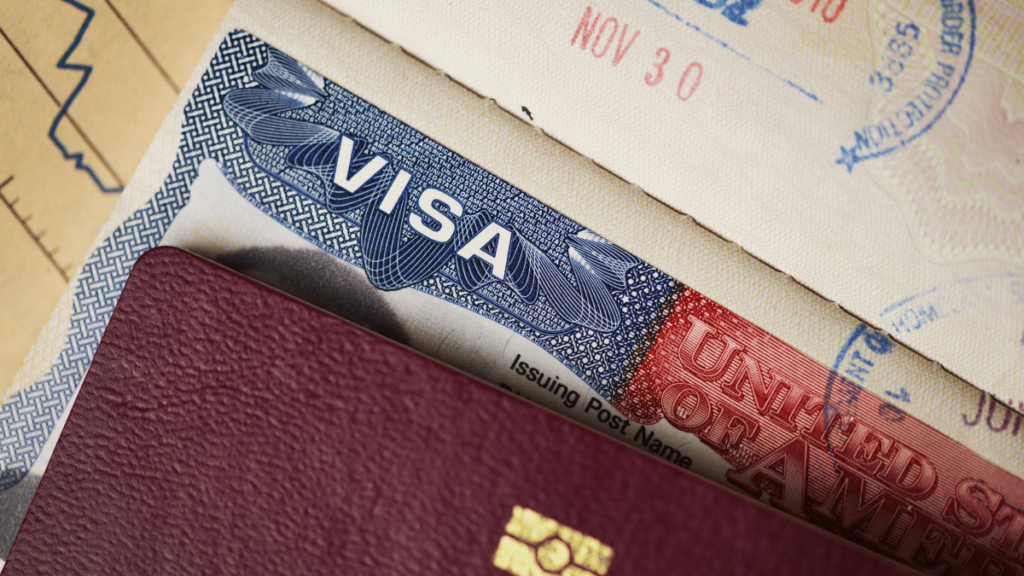
What is the EB-2 Visa?
The EB-2 visa is an employment-based immigrant visa for professionals with exceptional abilities or advanced degrees. It requires sponsorship from a U.S. employer and a labor certification process (PERM) to demonstrate that no qualified U.S. workers are available for the job.
Key Criteria for EB-2 Visa:
- Advanced Degree: Master’s degree or higher (or a bachelor’s degree plus five years of progressive experience).
- Exceptional Ability: Significant expertise in sciences, arts, or business with documented evidence.
- Labor Certification: Employer must complete the PERM process to prove no suitable U.S. workers are available.
What is the EB-2 NIW (National Interest Waiver) Visa?
The EB-2 NIW visa is a special category under the EB-2 classification that allows applicants to bypass the labor certification process if their work is deemed to be in the “national interest” of the United States. This visa type does not require employer sponsorship.
Key Criteria for EB-2 NIW Visa:
- National Interest: The applicant’s work must have substantial merit and national importance.
- Waiver Justification: The applicant must demonstrate that waiving the labor certification would benefit the U.S.
- Self-Petition: Applicants can apply without employer sponsorship.
Key Differences Between EB-2 and EB-2 NIW Visas
| Feature | EB-2 Visa | EB-2 NIW Visa |
|---|---|---|
| Labor Certification | Required (PERM process) | Not required (waived due to national interest) |
| Employer Sponsorship | Mandatory | Not required (self-petition allowed) |
| Eligibility | Advanced degree or exceptional ability | Work of substantial merit and national importance |
| Processing Time | Longer due to PERM review | Generally faster without labor certification |
| Flexibility | Tied to employer | Greater freedom to change jobs |
Labor Certification Process (PERM): The EB-2 visa requires a labor certification (PERM) where the U.S. employer proves there are no qualified U.S. workers for the position. The EB-2 NIW visa does not require this, which can significantly speed up the process.
Eligibility Criteria: While both visas require advanced qualifications, the EB-2 NIW requires the applicant to show that their work is in the national interest, a criterion that does not apply to the standard EB-2 visa.
Processing Time Comparison: The EB-2 visa process can be longer due to the labor certification requirement, whereas EB-2 NIW may be processed faster since this step is waived.

Who Qualifies for an EB-2 Visa?
You may qualify for an EB-2 visa if you meet one of the following criteria:
- You hold an advanced degree (master’s or higher) or a bachelor’s degree with five years of progressive experience.
- You possess exceptional ability in the sciences, arts, or business, demonstrated through consistent recognition and expertise.
Who Is Eligible for the EB-2 NIW Visa?
To qualify for an EB-2 NIW visa, you must:
- Demonstrate that your work is of substantial merit and national importance.
- Show that you are well-positioned to advance your work.
- Prove that waiving the labor certification requirement is beneficial to the U.S.
Advantages and Disadvantages of EB-2 and EB-2 NIW Visas
When considering whether to apply for an EB-2 or an EB-2 NIW visa, it is crucial to weigh the advantages and disadvantages of each option. Both visas provide a path to U.S. permanent residency but have distinct requirements and benefits. Understanding these pros and cons will help you decide which route aligns better with your professional goals and immigration circumstances.
| Feature | EB-2 Visa | EB-2 NIW Visa |
| Advantages | – Clear criteria with employer support. – Suitable for professionals with a strong employer sponsor. | – No employer sponsorship required (self-petition possible). – Faster process due to waived labor certification.- Greater career flexibility. |
| Disadvantages | – Requires labor certification (lengthy and complex). – Limits job flexibility due to employer sponsorship. | – Higher burden of proof (national interest requirement). – Requires substantial evidence to justify the waiver. |
Which Visa Is Right for You: EB-2 or EB-2 NIW
Deciding between the EB-2 vs. EB-2 NIW visas depends on your specific qualifications, career goals, and whether you have an employer willing to sponsor you. Both visas offer a path to U.S. permanent residency, but they differ in terms of requirements and benefits. Below are the factors to consider when choosing the right option for you.
Choose EB-2 Visa If:
- You have a U.S. employer willing to sponsor you.
- You meet the advanced degree or exceptional ability criteria.
Choose EB-2 NIW Visa If:
- Your work has substantial merit and national importance.
- You prefer to self-petition without employer sponsorship.
- You seek greater job flexibility.
Final Thoughts: Choosing Between EB-2 and EB-2 NIW
Both the EB-2 visa and the EB-2 NIW visa offer pathways to U.S. permanent residency for qualified professionals. The right choice depends on your qualifications, employer sponsorship availability, and whether your work serves the national interest. Understanding the differences and meeting the eligibility requirements is crucial for a successful application. If you’re unsure which visa fits your situation, consulting with an immigration attorney can provide personalized guidance and improve your chances of success.
If you’re considering the EB-2 vs. EB-2 NIW visa as a pathway to U.S. permanent residency and eventually citizenship, understanding the key distinctions between these visa categories is crucial. This article outlines the eligibility, application process, and pros and cons of both options to help you make an informed decision. With careful planning and a well-prepared application, you can increase your chances of success. For additional support, you can reach out to CK Law Firm official website, or connect with me on LinkedIn for more personalized guidance.
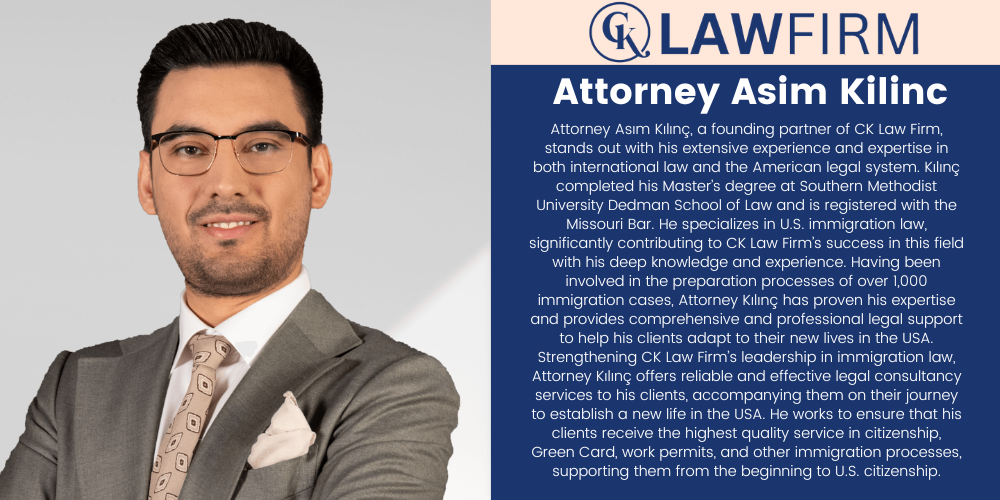
Asım Kılınç, Immigration Attorney, CK Law Firm
The H1B visa is a significant opportunity for foreign professionals seeking to work in the United States. However, to apply for this visa, you must meet specific requirements and prepare all necessary H-1B visa documents thoroughly. In this article, I will cover the following topics related to the H-1B visa requirements and the application process:
- Understanding the H-1B Visa Requirements
- Required Documents for the H-1B Visa
- How Does the H-1B Visa Application Process Work?
- Frequently Asked Questions About the H-1B Visa
If you have additional questions about the H-1B visa, feel free to reach out through the comments section of this blog or via the website of CK Law Firm, our immigration law firm. For personalized inquiries and consultancy services, you can also connect with me directly on LinkedIn.
Understanding the H-1B Visa Requirements
To fully understand the H1B visa requirements, it is essential to first know about USCIS (U.S. Citizenship and Immigration Services). As the main agency managing the H1B visa, USCIS evaluates applications based on specific criteria. Meeting these criteria ensures compliance with H-1B visa conditions. So, who qualifies for an H1B visa? According to USCIS, the following are key requirements:
- Job Offer: Applicants must have a formal job offer from a U.S.-based company.
- Specialized Expertise: The job must require specialized skills, and the applicant should have expertise in that field. Examples include software development, engineering, finance, or healthcare.
- Educational Background: Since the H1B visa is not open to everyone, applicants must hold at least a bachelor’s degree or its equivalent.
- Sponsoring Employer: The U.S. company not only provides the job offer but also takes responsibility for submitting the majority of the visa application on behalf of the applicant.
Necessary Documents for the H-1B Visa
The documentation needed for the H1B visa application process can be categorized into two main groups: documents required from the applicant and those required from the employer. Here, I will outline the documents you need to prepare as the applicant:
- Passport: A valid passport along with copies of any previous passports.
- Identification Document: Your national ID card.
- Photograph: A biometric photo that meets U.S. visa application standards.
Additionally, keep the following points in mind:
- Foreign applicants must ensure that their passport is valid for at least the duration of the visa.
- Any documents prepared in a language other than English must be submitted with notarized English translations.
Preparing these documents accurately is essential to ensure a smooth application process.
Educational and Professional Documents for the H-1B Visa
The H1B visa is designed for professionals, so you must provide evidence of your qualifications through proper documentation. Before applying, ensure you prepare the following documents required for the H1B visa:
- Diploma: A bachelor’s or master’s degree along with your transcripts.
- Work Experience Letters: Reference letters and proof of prior work experience from previous employers.
- Certificates: Training or specialization certificates relevant to your field.
For foreign applicants, it may be necessary to submit diplomas from universities recognized in their home country as equivalent to U.S. standards. Additionally, all academic documents must be accompanied by notarized English translations to meet application requirements.
Documents Provided by the Employer
During the H1B visa application process, your employer is responsible for submitting specific documents to support your application. The required documents from the employer include:
- Job Offer Letter: An official job offer letter from the company you will be working for.
- LCA (Labor Condition Application): A document that certifies the working conditions meet U.S. standards and that the job does not pose a threat to U.S. citizens’ employment opportunities.
- Form I-129: The official immigration form required for the H-1B visa application.
Ensuring that your employer provides complete and accurate documentation is crucial for a smooth application process. Clear communication with your employer is essential to avoid any delays or issues. For further details, you can also check our article titled “H-1B Visa Application Dates (2025 Guide).”
How Does the H-1B Visa Application Process Work?
Applicants must carefully follow the H1B visa requirements to ensure the process proceeds smoothly and efficiently. Understanding each step is crucial for a successful application. Here are the key steps in the H1B visa application process:
- Employer Sponsorship Application: Your employer submits Form I-129 to USCIS to sponsor your visa.
- Labor Condition Application (LCA): The employer must get the LCA certified by the U.S. Department of Labor to confirm compliance with working conditions.
- Payment of Application Fees: The required fees must be paid by the employer.
- Consulate Interview: The applicant attends a visa interview at the U.S. consulate.
It is vital for foreign applicants to ensure all documents are complete before their U.S. consulate interview. Additionally, being able to communicate clearly in English during the interview is crucial. Practicing English and preparing your documents ahead of time will help streamline the process.
Frequently Asked Questions About the H-1B Visa
Many applicants may have questions or uncertainties during the H1B visa application process. Below, I address some of the most frequently asked questions about the H1B visa:
- How Long Does It Take to Process an H1B Visa Application?
The processing time depends on the type of application and the volume of submissions. Typically, it takes 3-6 months under standard processing. However, those who need quicker results can opt for premium processing, which ensures a decision within 15 days.
- Who Pays the H1B Visa Application Fees?
Most of the application fees are covered by the employer. However, some costs, such as fees for the consulate interview, are the responsibility of the applicant.
- What Should You Prepare for the H1B Visa Interview?
It is crucial to ensure all your documents are complete before attending the consulate interview. Double-check your paperwork beforehand. Since the interview will be conducted in English, practicing your responses in English ahead of time can be very beneficial.
- What Are the Educational Requirements for an H1B Visa?
Applicants must hold at least a bachelor’s degree. The education level should align with the requirements of the position being applied for.
- Can H1B Visa Holders Apply for a Green Card?
Yes, H1B visa holders are eligible to transition to the Green Card process. This process can be initiated through employer sponsorship, allowing you to obtain permanent residency in the United States.
In this article, I covered the H-1B visa requirements and the necessary documents for the application. If you have additional questions, feel free to reach out through the comments section of this blog or via our website. For personalized inquiries or to benefit from my consultancy services, you can also connect with me on LinkedIn.
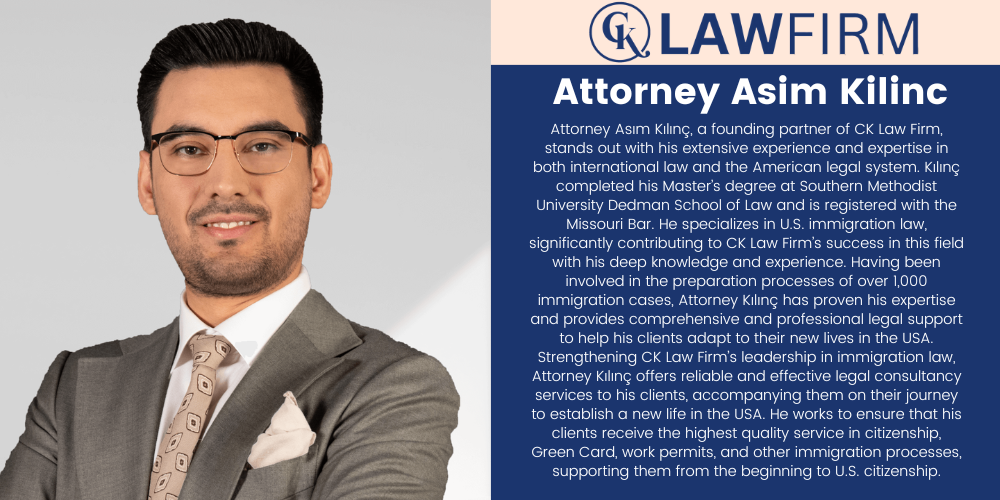
By Ergul Celiksoy, Immigration Attorney at CK Law Firm
The H-1B visa offers a unique opportunity for Turkish professionals seeking to work in the United States. However, the application process for this visa requires detailed planning and accurate information. In this article, I cover essential topics related to H-1B visa application dates, including:
- What is the H-1B visa, and who is eligible to apply?
- 2025 H-1B Visa Application Dates
- H-1B Visa Fees
- How long does it take to get an H-1B visa?
- H-1B Visa Requirements
If you have additional questions beyond these topics, feel free to reach out through the comments section of this blog or the official CK Law Firm website. For personalized inquiries and consultancy services, you can also connect with me on LinkedIn.
What is the H-1B Visa, and Who is Eligible to Apply?
The H-1B visa is a work visa granted to foreign professionals seeking to work in specialized occupations in the United States. This visa is specifically designed for individuals specializing in fields such as technology, engineering, finance, and healthcare. So, who is eligible to apply for an H-1B visa?
- Educational Requirement: Applicants must hold at least a bachelor’s degree or its equivalent in education or experience.
- Job Offer: You cannot apply for this visa independently. An offer of employment from a U.S.-based company is required.
- Specialized Fields: The H-1B visa is not open to all professions. Applicants must have expertise in fields designated by USCIS (United States Citizenship and Immigration Services).
What is USCIS?
USCIS stands for “U.S. Citizenship and Immigration Services,” the agency responsible for managing H-1B visa applications. Your application’s success largely depends on meeting the eligibility criteria set by this agency. For this reason, it is crucial for every professional applying for an H-1B visa to thoroughly review the information and guidelines provided by USCIS.
2025 H-1B Visa Application Dates
Applications for the H-1B visa follow a specific timeline each year. While the official application dates for 2025 have not yet been announced, the general process typically unfolds as follows:
- Early April Start: USCIS usually opens the application process during the first week of April.
- Quota Filling Period: The H-1B visa cap often fills within a few days, depending on the volume of applications. Submitting your application as early as possible is strongly recommended.
- No Official Deadline: There is no fixed deadline for submitting applications. Therefore, it is crucial to file your application as soon as the process begins.
Professionals intending to apply for the H-1B visa should ensure they are fully prepared before the application window opens. Completing all required documents in advance will help your application process proceed smoothly and efficiently.
H-1B Visa Fees
The H-1B visa fees are a critical aspect of the application process. Being financially prepared in advance can help you avoid any unexpected challenges. Here are the key costs associated with the H-1B visa application:
- Application Fee: $460 (the basic fee for the H-1B application)
- Anti-Fraud Fee: $500 (aimed at preventing fraudulent applications)
- Premium Processing Fee (Optional): $2,500 (ensures a decision within 15 days)
- Education and Workforce Fee: $750–$1,500 (varies based on the size of the employer and is typically paid by the employer)
Understanding these costs will allow applicants and employers to budget effectively for the H-1B visa process.
How Long Does it Take to Get an H-1B Visa?
Once you’ve submitted your application, the waiting period begins—often filled with anticipation. Many professionals start asking, “How long does it take to get an H-1B visa?” The typical timeline is as follows:
- Standard Processing Time: Applications are generally processed within 3 to 6 months.
- Expedited Processing: By paying an additional fee for premium processing, you can receive a decision within 15 days.
- Request for Additional Evidence (RFE): If USCIS requests further documentation, it may extend the timeline.
To ensure a smooth process, it’s essential to be well-prepared before the application period begins. For additional guidance, check out our article, “H1B Visa: A Special Guide for Those Who Want to Work in America” before starting your application journey.
H-1B Visa Requirements
The H-1B visa is not suitable for everyone, which is why understanding the H-1B visa requirements is crucial before applying. Candidates who meet these criteria can confidently submit their applications. Key requirements include:
- Educational Qualifications: Applicants must meet the required education level.
- Proof of Expertise: Documentation of your specialized skills is necessary.
- Job Offer: A valid job offer from a U.S.-based employer is mandatory.
Candidates who fulfill these requirements can apply and await the results. Successful applicants often have the opportunity to move to the U.S. with their families. While the process can be challenging, its focus on specialized professionals increases the likelihood of approval, making it a highly attainable goal for eligible individuals.
Application Tips and Recommendations
To complete the H-1B visa application process with minimal difficulty, consider the following essential tips:
- Prepare All Required Documents: Ensure your job offer letter, academic credentials, and professional certifications are complete and accurate.
- Apply Early: Since the visa cap fills quickly, submit your application as early as possible.
- Seek Expert Support: Working with an immigration attorney can simplify the process and improve your chances of success.
If you are planning to apply for an H-1B visa, feel free to reach out to us. You can ask your questions in the comments section below this article or message me directly on LinkedIn. Stay prepared before the application window opens by contacting us at any time for guidance and support.
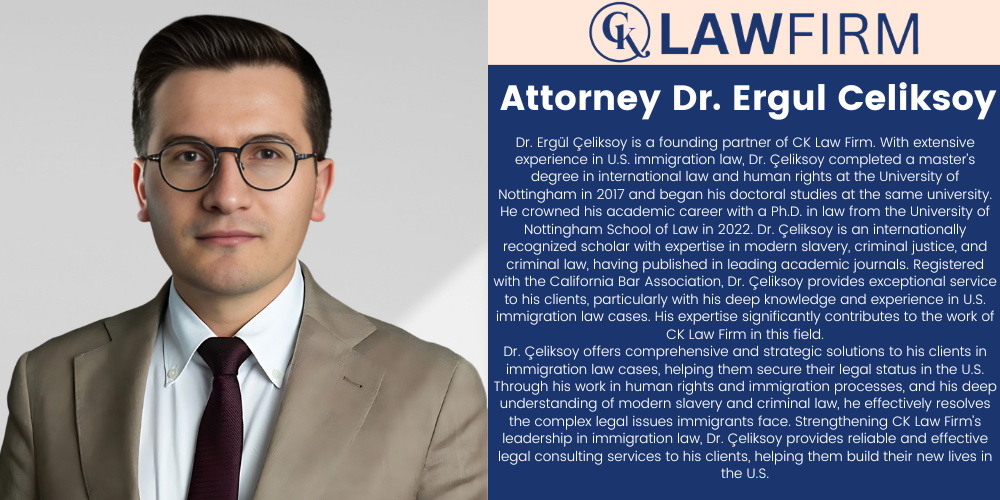
By Ergul Celiksoy, Immigration Attorney at CK Law Firm
The E-2 visa is one of the most advantageous visas available for investors in the United States. This visa allows citizens of countries with a trade agreement with the U.S. to establish or manage a business in the U.S. by making a certain amount of investment. The flexible structure of the E-2 visa offers significant opportunities for those considering investing in the logistics sector. In this article, we will explore the details of the E-2 visa:
- What is the E-2 Visa?
- Why the Logistics Sector?
- What Are the Requirements for Obtaining an E-2 Visa in the Logistics Sector?
- The E-2 Visa Application Process
- Differences Between Applying for an E-2 Visa from Turkey or the U.S.
If you have any other questions related to this topic, feel free to leave a comment at the end of this article, send me a message directly on LinkedIn, or contact me through the website of CK Law Firm, where I am a co-founder!
What is the E-2 Visa?
The E-2 visa is a type of visa available to investors who want to establish or manage a business in the U.S. It requires making an investment that contributes to the U.S. economy with a certain amount of capital. This visa type allows the applicant and their family to live and work in the U.S. However, as a non-immigrant visa, it does not grant permanent residency (Green Card). Nevertheless, as long as the business continues, the E-2 visa can be renewed indefinitely.
Why the Logistics Sector?
The logistics sector in the U.S. is a rapidly growing area offering significant opportunities to investors. At a time when global trade is increasing, e-commerce is accelerating, and supply chains are becoming more complex, investing in the logistics sector can be highly profitable. Logistics not only involves transportation but also includes warehousing, inventory management, shipping, and supply chain optimization. This wide range of services allows investors to enter the sector with different business models.
What Are the Requirements for Obtaining an E-2 Visa in the Logistics Sector?
Investment Amount and Business Model:
The amount of investment in the logistics sector can vary depending on the type of business. Generally, no specific investment amount is required for the E-2 visa. However, the investment is expected to be “substantial.” A minimum investment amount between $100,000 and $200,000 is recommended, depending on the type and scale of the business. The investment must support the sustainable operation of the business and demonstrate profitability potential.Common investment models in the logistics sector include:
- Starting a transportation company
- Establishing warehousing and distribution centers
- Offering supply chain management services
Investment Must Be at Risk:
To obtain an E-2 visa, the investment must be “at risk.” This means the money invested must be tied to the business, and there must be a risk of losing the capital if the business is not successful. This criterion demonstrates the investor’s commitment to developing their business.
Business Sustainability:
The business you establish in the logistics sector must be sustainable. It should not only support the investor and their family but also contribute to the U.S. economy. The business’s potential for growth, job creation, and economic benefit to the U.S. will strengthen the visa application.
The E-2 Visa Application Process
- Eligibility by Nationality: To apply for an E-2 visa, you must be a citizen of a country with a trade agreement with the U.S. Turkey is among the countries eligible to apply for an E-2 visa.
- Business Plan Preparation: Presenting a detailed and realistic business plan is crucial for E-2 visa applications. You must provide a comprehensive business plan showing how your investment in the logistics sector will operate, its goals, profitability projections, and its contribution to the U.S. economy. Your business plan should convince the visa officer of the sustainability and credibility of your business and investment.
- Visa Application and Interview: After preparing the necessary documents, you can apply for the visa through the U.S. Consulate. During the E-2 visa application, an interview is conducted, focusing on the sustainability of your business model and the legitimacy of your investment. It is essential to thoroughly understand your business plan and model before attending the interview.
Differences Between Applying for an E-2 Visa from Turkey or the U.S.
The E-2 investor visa can be applied for both from within the U.S. and from U.S. Consulates abroad. However, there are important differences in terms of process and outcomes depending on where the application is submitted. Understanding these differences can help shape the strategy for investors considering applying from Turkey or the U.S.
Application Location: Consular Application from Turkey vs. Change of Status in the U.S.
From Turkey:
Investors residing in Turkey apply for the E-2 visa through the U.S. Embassy or Consulate. In consular applications, the process is primarily evaluated by consular officers, and if approved, the investor is directly granted the E-2 visa, allowing entry to the U.S. to manage their investment.
Advantages:
- Entry to the U.S.: Once you are granted an E-2 visa from the Consulate, you can enter the U.S. and stay throughout the visa validity period.
- Visa Duration: For Turkish citizens, the visa is typically granted for 5 years and can be renewed.
- Ease of Travel: With the E-2 visa, you can leave the U.S. and re-enter freely during the visa’s validity.
Disadvantages:
- Interview Requirement: A face-to-face interview at the U.S. Consulate is mandatory, which can be a stressful process.
- Initial Investment: A significant portion of the investment must be made before entering the U.S., which can complicate business management.
From the U.S.:
Investors already in the U.S. on a different visa (such as a tourist visa) can apply to change their status to an E-2 visa through the U.S. Citizenship and Immigration Services (USCIS).
Advantages:
- No Interview: In most cases, no interview is required for USCIS applications.
- Staying in the U.S.: Once approved, you can remain in the U.S. and manage your business.
- Starting the Business: Being physically in the U.S. can make it easier to start and manage the business.
Disadvantages:
Travel Restrictions: Changing status does not grant you a visa. If you leave the U.S., your E-2 status ends, and you will need to apply for an E-2 visa at a U.S. Consulate.
No Visa Issuance: The change of status process only provides a legal status change, not a visa. To travel outside the U.S., you will need to obtain a consular visa.
Processing Time:
From Turkey: Consular applications typically result faster, usually taking 2-3 months, depending on the consulate’s workload.
From the U.S.: Applications for status change take longer, usually 4-6 months. However, for an additional fee, premium processing can provide results within 15 days.
Visa Duration and Renewal:
From Turkey: For Turkish citizens, the visa is typically issued for 5 years. As long as the business continues, the visa can be renewed, and the investor and their family can leave and re-enter the U.S.
From the U.S.: A status change to E-2 typically grants a 2-year stay. Before this period ends, you can apply to USCIS for an extension. However, this status does not allow for travel outside the U.S. without first applying for a visa at a U.S. Consulate.
Family Members’ Status:
From Turkey: Family members can apply for an E-2 visa along with the investor. The spouse can apply for work authorization in the U.S., and children can attend school.
From the U.S.: Family members can apply for a status change along with the investor. The spouse can apply for a work permit, and children can continue their education. However, if family members wish to travel outside the U.S., they must obtain a visa from the U.S. Consulate.
Conclusion
Investing in the logistics sector to obtain an E-2 visa presents a significant opportunity for investors aiming to establish a business in the U.S. The size of the investment, the sustainability of the business, and its contribution to the U.S. economy are key factors in the application process. The rapid growth and demand in the logistics sector make investment in this area attractive, while the E-2 visa serves as a supportive tool in this process.
If you are considering investing in the U.S. logistics sector, CK Law Firm can offer you professional support throughout your E-2 visa application process. For professional assistance, detailed information, and consultancy services, feel free to reach out to us at cklawfirm.org, via email at info@cklawfirm.org, or through LinkedIn.
Who is Attorney Ergül Çeliksoy?
Attorney Dr. Ergül Çeliksoy is a founding partner of CK Law Firm and also serves as an Assistant Professor of Law at the University of Nottingham. With extensive experience in U.S. immigration law, Dr. Çeliksoy completed a Master’s degree in international law and human rights law at the University of Nottingham in 2017, followed by a Ph.D. at the same university. His Ph.D., completed in 2022 at the University of Nottingham School of Law, marked a significant milestone in his academic career. Dr. Çeliksoy has published extensively in leading academic journals and is internationally recognized for his expertise in modern slavery, criminal justice, and criminal law. As a member of the California Bar, Dr. Çeliksoy offers exceptional service to his clients, particularly in U.S. immigration law cases. His expertise and experience in immigration law significantly contribute to CK Law Firm’s work in this area.
Dr. Çeliksoy provides comprehensive and strategic solutions to his clients in immigration law cases, helping secure their legal status in the U.S. His work on human rights and immigration processes, particularly in modern slavery and criminal law, effectively addresses the complex legal issues immigrants face. Dr. Çeliksoy reinforces CK Law Firm’s leadership in immigration law by offering reliable and effective legal consulting services to his clients, helping them build new lives in the United States.
Subscribe to Our Newsletter
Subscribe to our newsletter to stay informed about the latest announcements and articles written by our attorneys on U.S. immigration processes.
Sobre Nosotros
Contáctanos
+1 (945) 527- 23 22
Correo electrónico
info@cklawfirm.org
Dirección
2800 Regal Rd #102, Plano, TX 75075

All Rights Reserved by CK Law Firm.


